Detailed Report: Management and Operations of the Arcadia Group
VerifiedAdded on 2020/10/05
|14
|4371
|402
Report
AI Summary
This report examines management and operations within the Arcadia Group, a clothing retailer. It begins with an introduction to organizational structure, focusing on functional structures and their benefits for a large organization like Arcadia. The report then explores the roles of managers and leaders, highlighting their characteristics and differences, such as the leader's visionary role versus the manager's focus on execution and strategy. It further delves into the application of management and leadership in various organizational situations, addressing issues like dealing with difficult employees and adapting to low productivity. The report also discusses different leadership theories, including Systems Leadership, Situational Leadership, and Contingency Theory, explaining how these theories can be applied to drive effective organizational behavior and decision-making. Finally, it considers the impact of the business environment on operations management and decision-making processes, concluding with a reflection on the importance of effective leadership and management for the growth and sustainable performance of the organization.
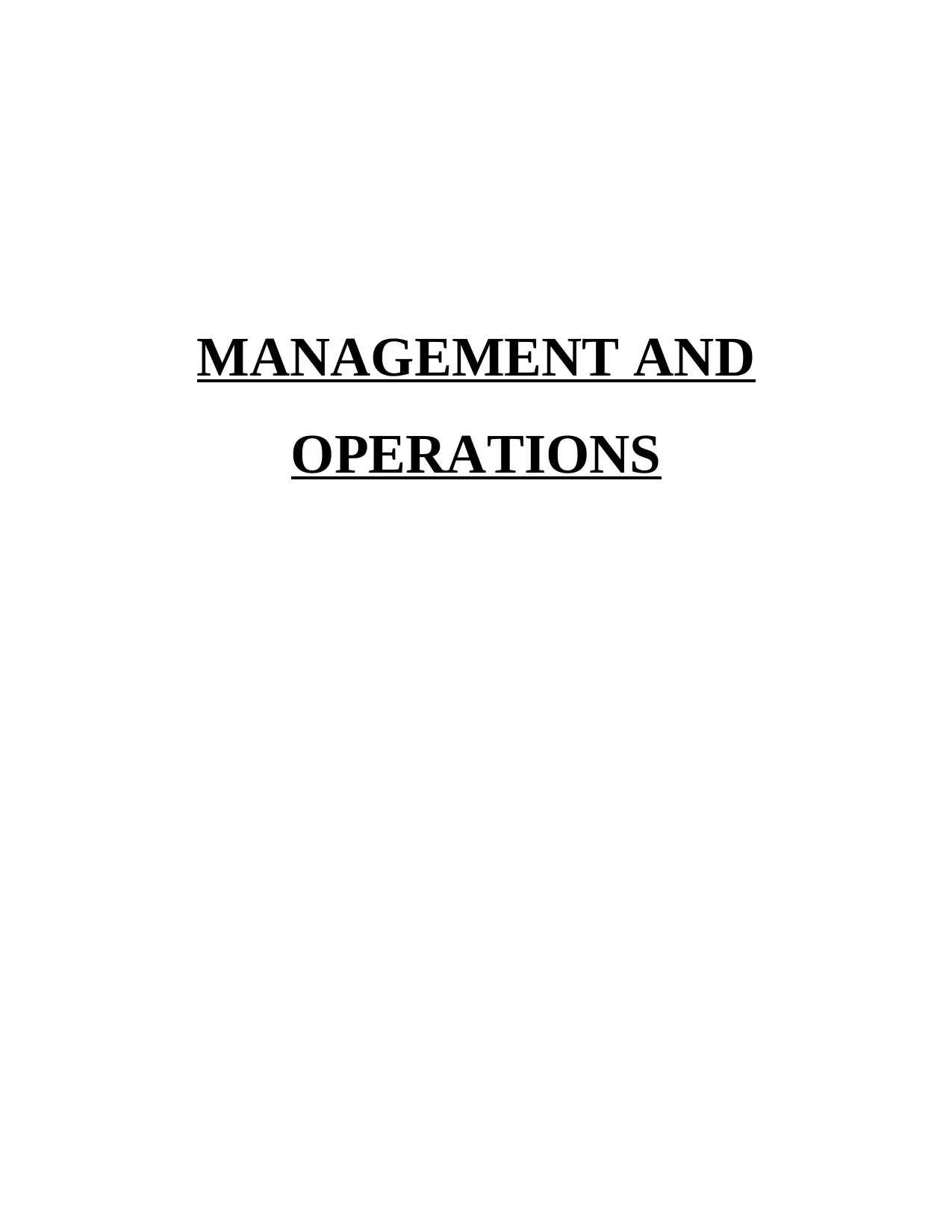
MANAGEMENT AND
OPERATIONS
OPERATIONS
Paraphrase This Document
Need a fresh take? Get an instant paraphrase of this document with our AI Paraphraser
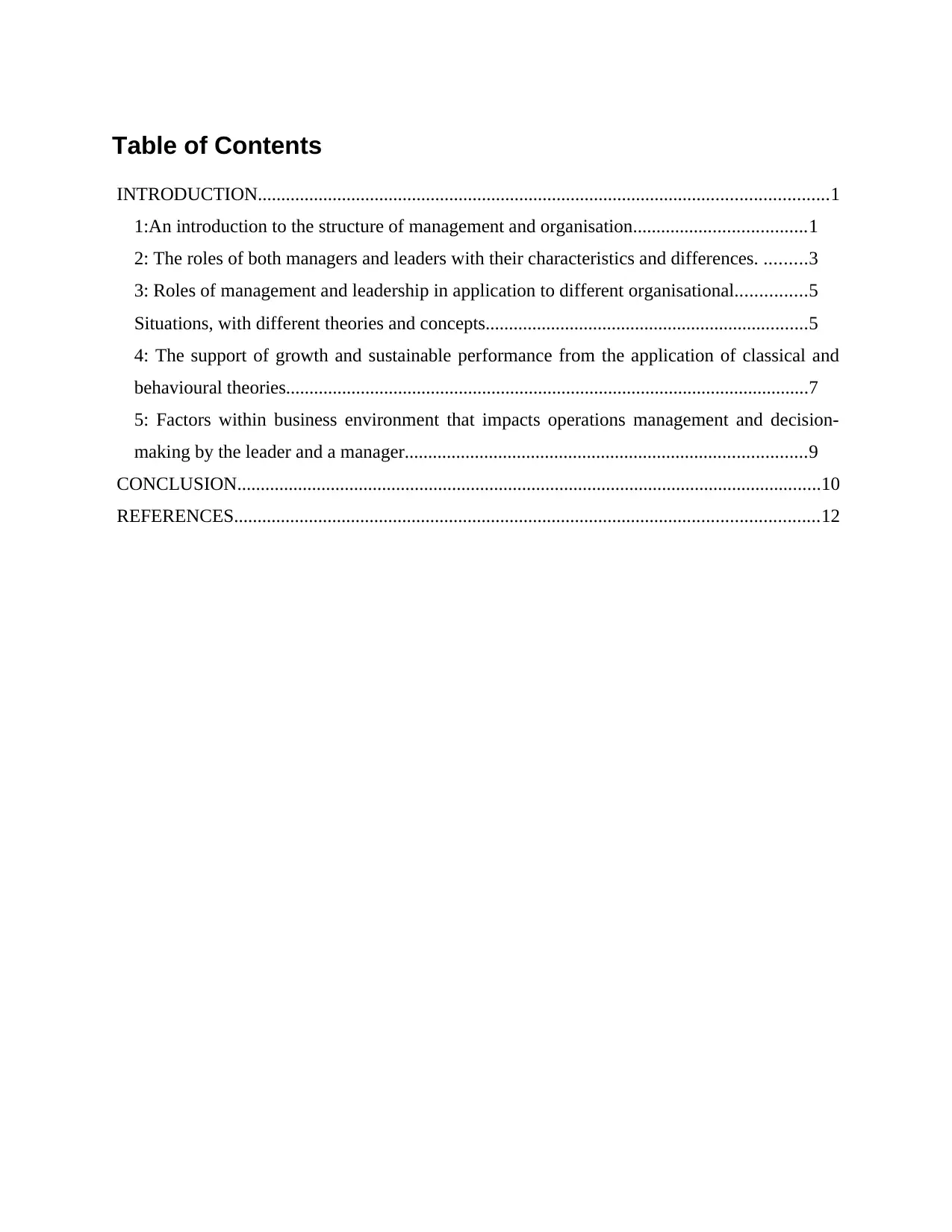
Table of Contents
INTRODUCTION..........................................................................................................................1
1:An introduction to the structure of management and organisation.....................................1
2: The roles of both managers and leaders with their characteristics and differences. .........3
3: Roles of management and leadership in application to different organisational...............5
Situations, with different theories and concepts.....................................................................5
4: The support of growth and sustainable performance from the application of classical and
behavioural theories................................................................................................................7
5: Factors within business environment that impacts operations management and decision-
making by the leader and a manager......................................................................................9
CONCLUSION.............................................................................................................................10
REFERENCES.............................................................................................................................12
INTRODUCTION..........................................................................................................................1
1:An introduction to the structure of management and organisation.....................................1
2: The roles of both managers and leaders with their characteristics and differences. .........3
3: Roles of management and leadership in application to different organisational...............5
Situations, with different theories and concepts.....................................................................5
4: The support of growth and sustainable performance from the application of classical and
behavioural theories................................................................................................................7
5: Factors within business environment that impacts operations management and decision-
making by the leader and a manager......................................................................................9
CONCLUSION.............................................................................................................................10
REFERENCES.............................................................................................................................12
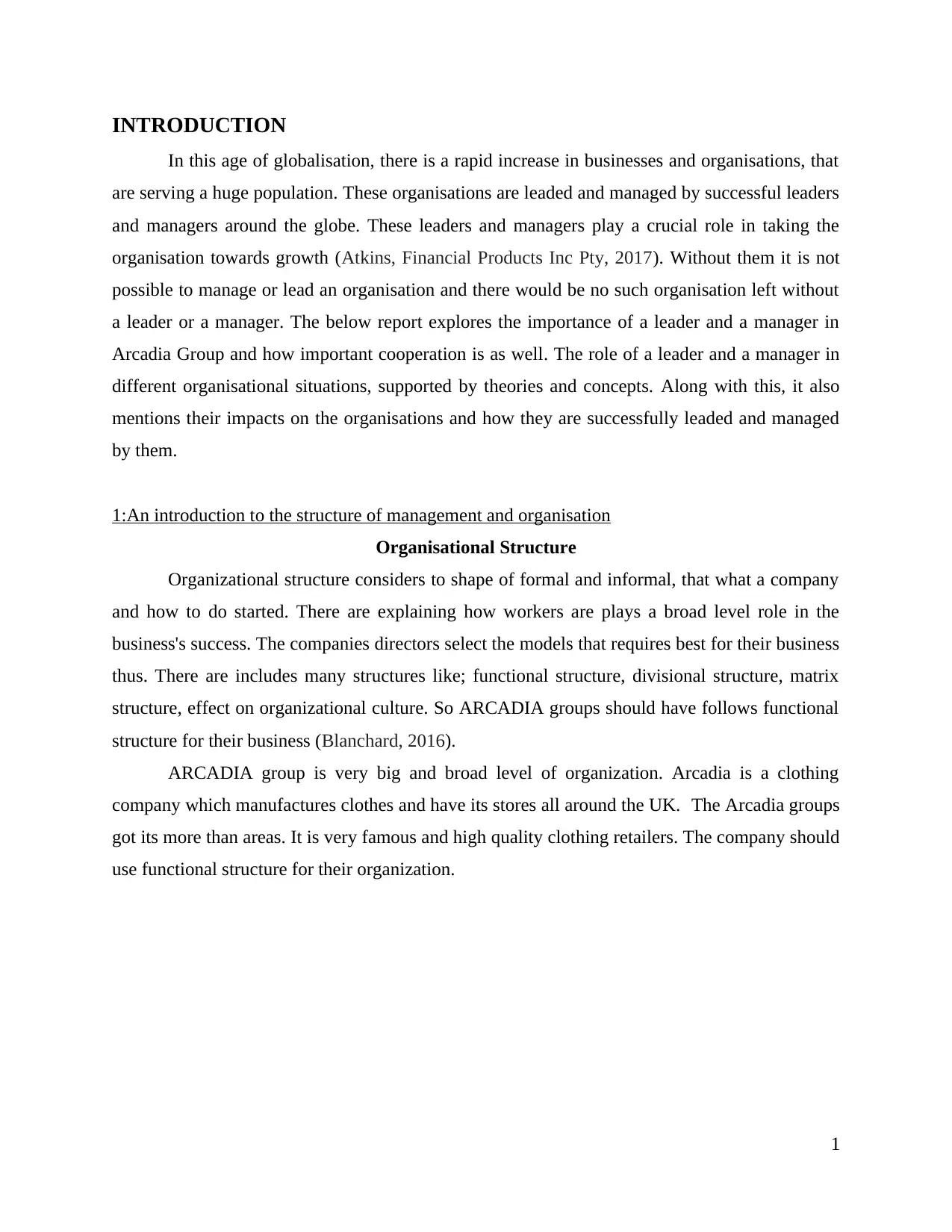
INTRODUCTION
In this age of globalisation, there is a rapid increase in businesses and organisations, that
are serving a huge population. These organisations are leaded and managed by successful leaders
and managers around the globe. These leaders and managers play a crucial role in taking the
organisation towards growth (Atkins, Financial Products Inc Pty, 2017). Without them it is not
possible to manage or lead an organisation and there would be no such organisation left without
a leader or a manager. The below report explores the importance of a leader and a manager in
Arcadia Group and how important cooperation is as well. The role of a leader and a manager in
different organisational situations, supported by theories and concepts. Along with this, it also
mentions their impacts on the organisations and how they are successfully leaded and managed
by them.
1:An introduction to the structure of management and organisation
Organisational Structure
Organizational structure considers to shape of formal and informal, that what a company
and how to do started. There are explaining how workers are plays a broad level role in the
business's success. The companies directors select the models that requires best for their business
thus. There are includes many structures like; functional structure, divisional structure, matrix
structure, effect on organizational culture. So ARCADIA groups should have follows functional
structure for their business (Blanchard, 2016).
ARCADIA group is very big and broad level of organization. Arcadia is a clothing
company which manufactures clothes and have its stores all around the UK. The Arcadia groups
got its more than areas. It is very famous and high quality clothing retailers. The company should
use functional structure for their organization.
1
In this age of globalisation, there is a rapid increase in businesses and organisations, that
are serving a huge population. These organisations are leaded and managed by successful leaders
and managers around the globe. These leaders and managers play a crucial role in taking the
organisation towards growth (Atkins, Financial Products Inc Pty, 2017). Without them it is not
possible to manage or lead an organisation and there would be no such organisation left without
a leader or a manager. The below report explores the importance of a leader and a manager in
Arcadia Group and how important cooperation is as well. The role of a leader and a manager in
different organisational situations, supported by theories and concepts. Along with this, it also
mentions their impacts on the organisations and how they are successfully leaded and managed
by them.
1:An introduction to the structure of management and organisation
Organisational Structure
Organizational structure considers to shape of formal and informal, that what a company
and how to do started. There are explaining how workers are plays a broad level role in the
business's success. The companies directors select the models that requires best for their business
thus. There are includes many structures like; functional structure, divisional structure, matrix
structure, effect on organizational culture. So ARCADIA groups should have follows functional
structure for their business (Blanchard, 2016).
ARCADIA group is very big and broad level of organization. Arcadia is a clothing
company which manufactures clothes and have its stores all around the UK. The Arcadia groups
got its more than areas. It is very famous and high quality clothing retailers. The company should
use functional structure for their organization.
1
⊘ This is a preview!⊘
Do you want full access?
Subscribe today to unlock all pages.

Trusted by 1+ million students worldwide
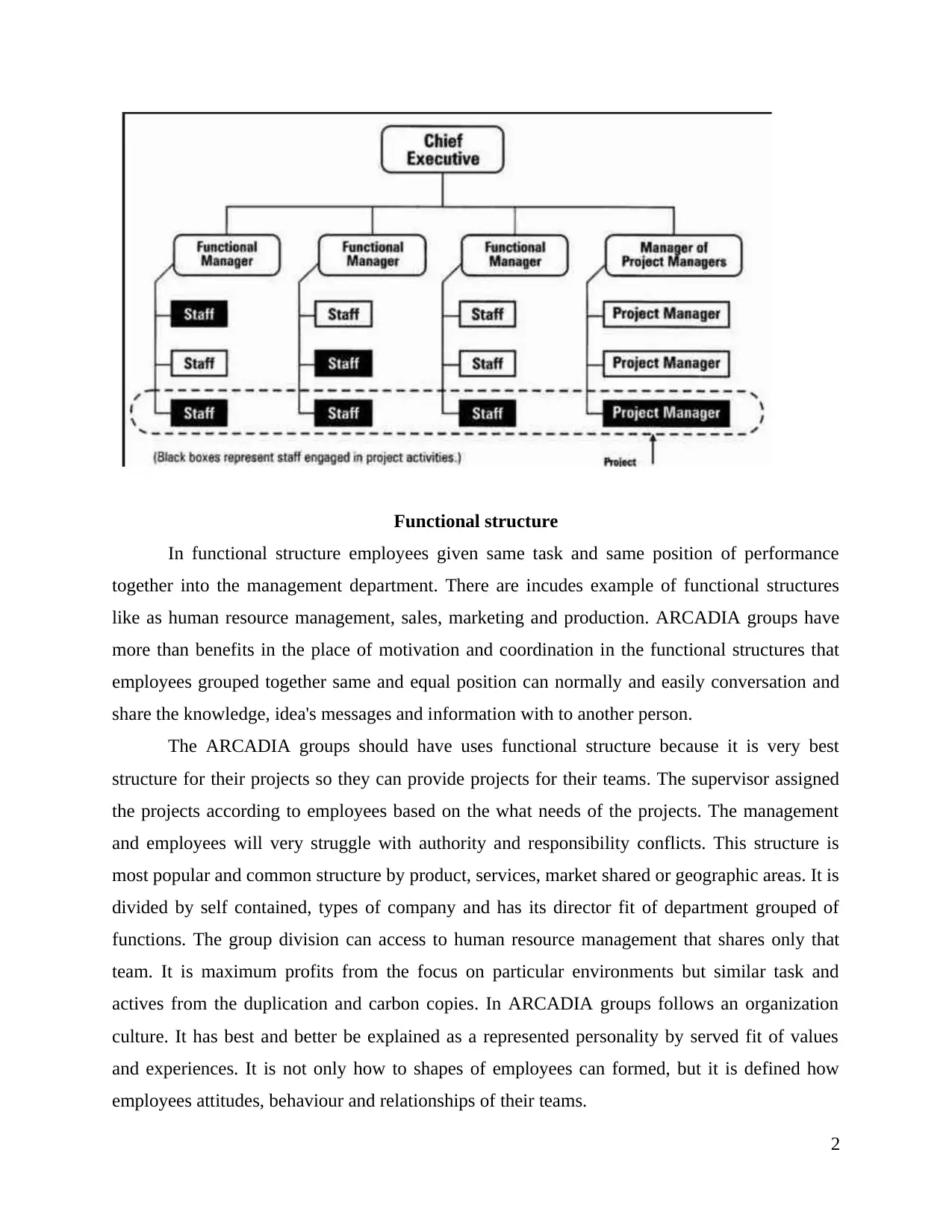
Functional structure
In functional structure employees given same task and same position of performance
together into the management department. There are incudes example of functional structures
like as human resource management, sales, marketing and production. ARCADIA groups have
more than benefits in the place of motivation and coordination in the functional structures that
employees grouped together same and equal position can normally and easily conversation and
share the knowledge, idea's messages and information with to another person.
The ARCADIA groups should have uses functional structure because it is very best
structure for their projects so they can provide projects for their teams. The supervisor assigned
the projects according to employees based on the what needs of the projects. The management
and employees will very struggle with authority and responsibility conflicts. This structure is
most popular and common structure by product, services, market shared or geographic areas. It is
divided by self contained, types of company and has its director fit of department grouped of
functions. The group division can access to human resource management that shares only that
team. It is maximum profits from the focus on particular environments but similar task and
actives from the duplication and carbon copies. In ARCADIA groups follows an organization
culture. It has best and better be explained as a represented personality by served fit of values
and experiences. It is not only how to shapes of employees can formed, but it is defined how
employees attitudes, behaviour and relationships of their teams.
2
In functional structure employees given same task and same position of performance
together into the management department. There are incudes example of functional structures
like as human resource management, sales, marketing and production. ARCADIA groups have
more than benefits in the place of motivation and coordination in the functional structures that
employees grouped together same and equal position can normally and easily conversation and
share the knowledge, idea's messages and information with to another person.
The ARCADIA groups should have uses functional structure because it is very best
structure for their projects so they can provide projects for their teams. The supervisor assigned
the projects according to employees based on the what needs of the projects. The management
and employees will very struggle with authority and responsibility conflicts. This structure is
most popular and common structure by product, services, market shared or geographic areas. It is
divided by self contained, types of company and has its director fit of department grouped of
functions. The group division can access to human resource management that shares only that
team. It is maximum profits from the focus on particular environments but similar task and
actives from the duplication and carbon copies. In ARCADIA groups follows an organization
culture. It has best and better be explained as a represented personality by served fit of values
and experiences. It is not only how to shapes of employees can formed, but it is defined how
employees attitudes, behaviour and relationships of their teams.
2
Paraphrase This Document
Need a fresh take? Get an instant paraphrase of this document with our AI Paraphraser
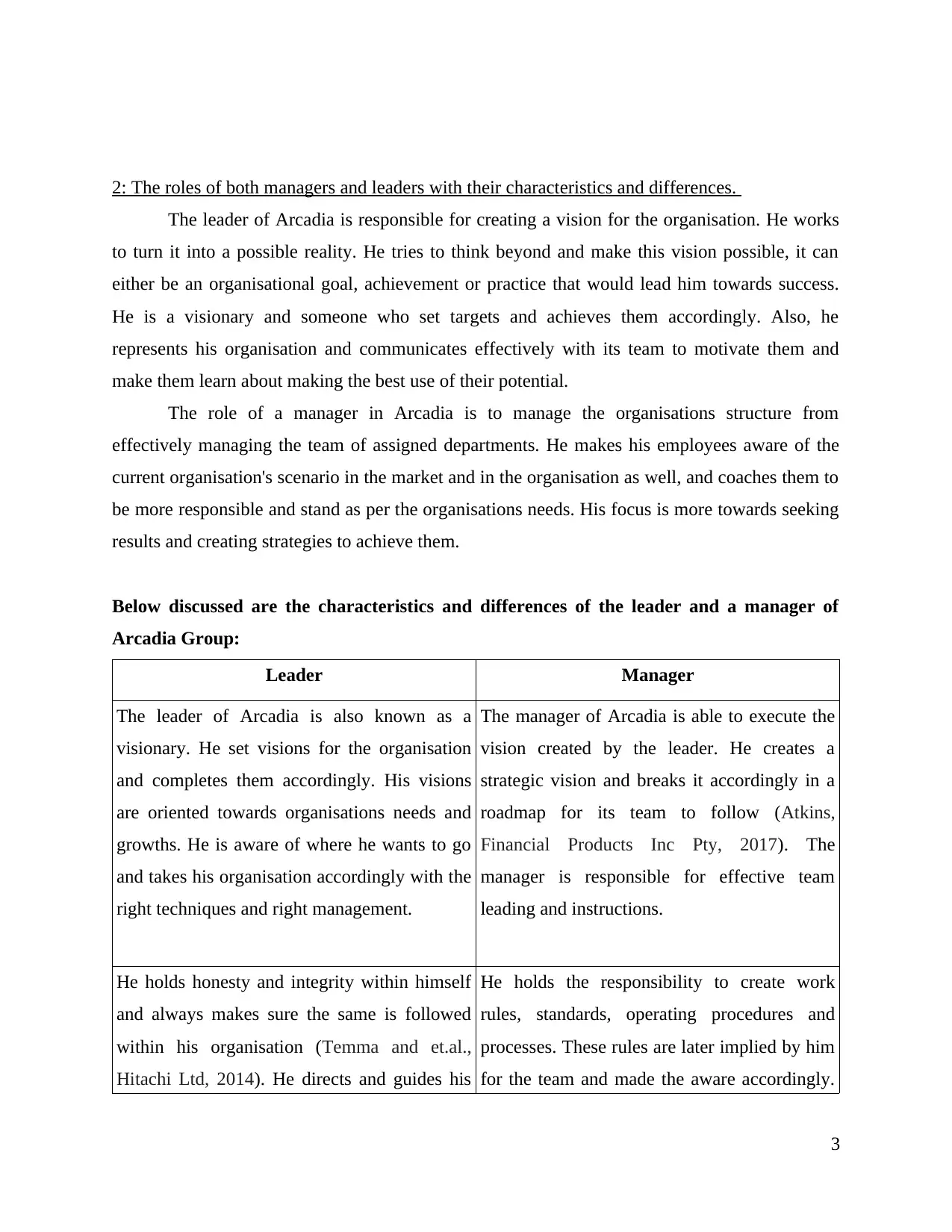
2: The roles of both managers and leaders with their characteristics and differences.
The leader of Arcadia is responsible for creating a vision for the organisation. He works
to turn it into a possible reality. He tries to think beyond and make this vision possible, it can
either be an organisational goal, achievement or practice that would lead him towards success.
He is a visionary and someone who set targets and achieves them accordingly. Also, he
represents his organisation and communicates effectively with its team to motivate them and
make them learn about making the best use of their potential.
The role of a manager in Arcadia is to manage the organisations structure from
effectively managing the team of assigned departments. He makes his employees aware of the
current organisation's scenario in the market and in the organisation as well, and coaches them to
be more responsible and stand as per the organisations needs. His focus is more towards seeking
results and creating strategies to achieve them.
Below discussed are the characteristics and differences of the leader and a manager of
Arcadia Group:
Leader Manager
The leader of Arcadia is also known as a
visionary. He set visions for the organisation
and completes them accordingly. His visions
are oriented towards organisations needs and
growths. He is aware of where he wants to go
and takes his organisation accordingly with the
right techniques and right management.
The manager of Arcadia is able to execute the
vision created by the leader. He creates a
strategic vision and breaks it accordingly in a
roadmap for its team to follow (Atkins,
Financial Products Inc Pty, 2017). The
manager is responsible for effective team
leading and instructions.
He holds honesty and integrity within himself
and always makes sure the same is followed
within his organisation (Temma and et.al.,
Hitachi Ltd, 2014). He directs and guides his
He holds the responsibility to create work
rules, standards, operating procedures and
processes. These rules are later implied by him
for the team and made the aware accordingly.
3
The leader of Arcadia is responsible for creating a vision for the organisation. He works
to turn it into a possible reality. He tries to think beyond and make this vision possible, it can
either be an organisational goal, achievement or practice that would lead him towards success.
He is a visionary and someone who set targets and achieves them accordingly. Also, he
represents his organisation and communicates effectively with its team to motivate them and
make them learn about making the best use of their potential.
The role of a manager in Arcadia is to manage the organisations structure from
effectively managing the team of assigned departments. He makes his employees aware of the
current organisation's scenario in the market and in the organisation as well, and coaches them to
be more responsible and stand as per the organisations needs. His focus is more towards seeking
results and creating strategies to achieve them.
Below discussed are the characteristics and differences of the leader and a manager of
Arcadia Group:
Leader Manager
The leader of Arcadia is also known as a
visionary. He set visions for the organisation
and completes them accordingly. His visions
are oriented towards organisations needs and
growths. He is aware of where he wants to go
and takes his organisation accordingly with the
right techniques and right management.
The manager of Arcadia is able to execute the
vision created by the leader. He creates a
strategic vision and breaks it accordingly in a
roadmap for its team to follow (Atkins,
Financial Products Inc Pty, 2017). The
manager is responsible for effective team
leading and instructions.
He holds honesty and integrity within himself
and always makes sure the same is followed
within his organisation (Temma and et.al.,
Hitachi Ltd, 2014). He directs and guides his
He holds the responsibility to create work
rules, standards, operating procedures and
processes. These rules are later implied by him
for the team and made the aware accordingly.
3
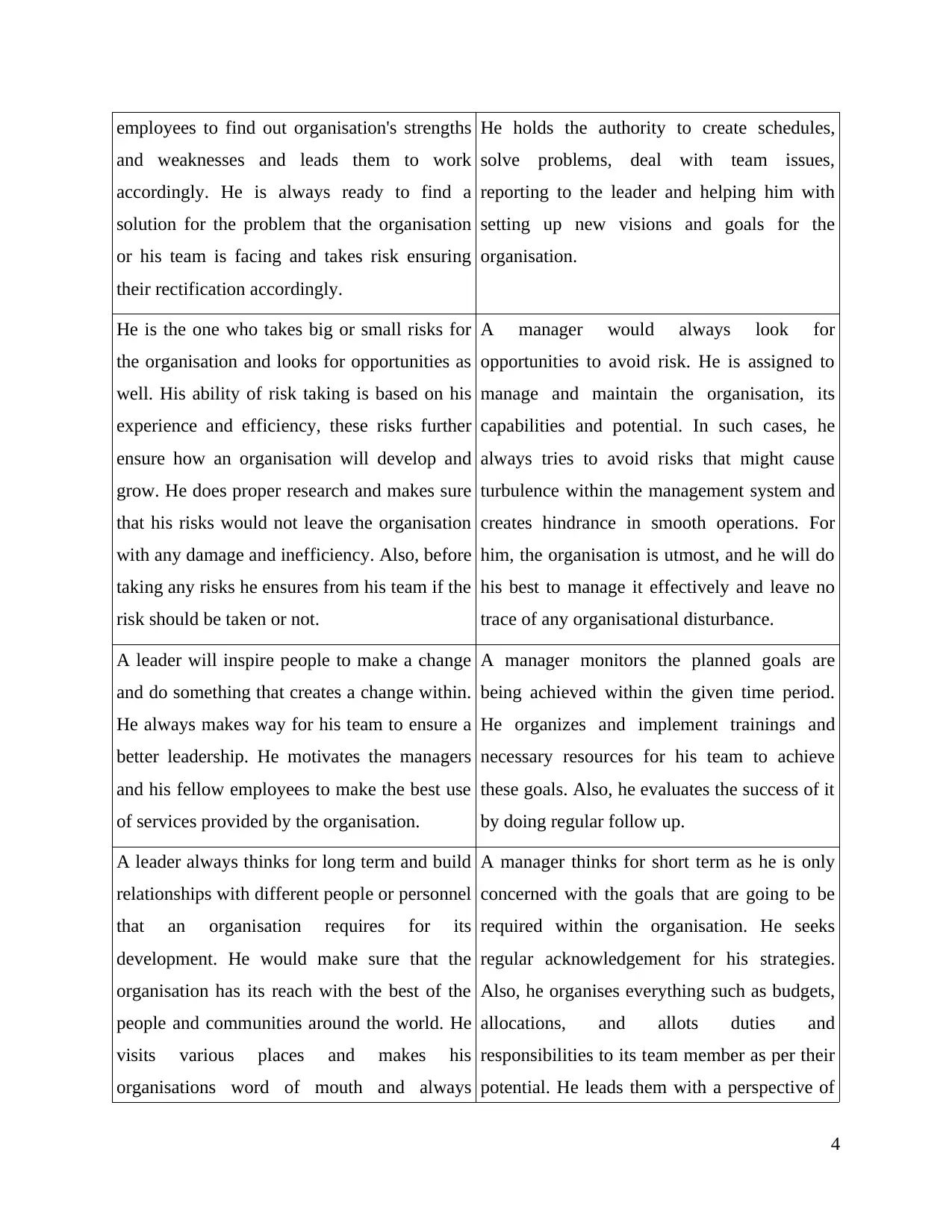
employees to find out organisation's strengths
and weaknesses and leads them to work
accordingly. He is always ready to find a
solution for the problem that the organisation
or his team is facing and takes risk ensuring
their rectification accordingly.
He holds the authority to create schedules,
solve problems, deal with team issues,
reporting to the leader and helping him with
setting up new visions and goals for the
organisation.
He is the one who takes big or small risks for
the organisation and looks for opportunities as
well. His ability of risk taking is based on his
experience and efficiency, these risks further
ensure how an organisation will develop and
grow. He does proper research and makes sure
that his risks would not leave the organisation
with any damage and inefficiency. Also, before
taking any risks he ensures from his team if the
risk should be taken or not.
A manager would always look for
opportunities to avoid risk. He is assigned to
manage and maintain the organisation, its
capabilities and potential. In such cases, he
always tries to avoid risks that might cause
turbulence within the management system and
creates hindrance in smooth operations. For
him, the organisation is utmost, and he will do
his best to manage it effectively and leave no
trace of any organisational disturbance.
A leader will inspire people to make a change
and do something that creates a change within.
He always makes way for his team to ensure a
better leadership. He motivates the managers
and his fellow employees to make the best use
of services provided by the organisation.
A manager monitors the planned goals are
being achieved within the given time period.
He organizes and implement trainings and
necessary resources for his team to achieve
these goals. Also, he evaluates the success of it
by doing regular follow up.
A leader always thinks for long term and build
relationships with different people or personnel
that an organisation requires for its
development. He would make sure that the
organisation has its reach with the best of the
people and communities around the world. He
visits various places and makes his
organisations word of mouth and always
A manager thinks for short term as he is only
concerned with the goals that are going to be
required within the organisation. He seeks
regular acknowledgement for his strategies.
Also, he organises everything such as budgets,
allocations, and allots duties and
responsibilities to its team member as per their
potential. He leads them with a perspective of
4
and weaknesses and leads them to work
accordingly. He is always ready to find a
solution for the problem that the organisation
or his team is facing and takes risk ensuring
their rectification accordingly.
He holds the authority to create schedules,
solve problems, deal with team issues,
reporting to the leader and helping him with
setting up new visions and goals for the
organisation.
He is the one who takes big or small risks for
the organisation and looks for opportunities as
well. His ability of risk taking is based on his
experience and efficiency, these risks further
ensure how an organisation will develop and
grow. He does proper research and makes sure
that his risks would not leave the organisation
with any damage and inefficiency. Also, before
taking any risks he ensures from his team if the
risk should be taken or not.
A manager would always look for
opportunities to avoid risk. He is assigned to
manage and maintain the organisation, its
capabilities and potential. In such cases, he
always tries to avoid risks that might cause
turbulence within the management system and
creates hindrance in smooth operations. For
him, the organisation is utmost, and he will do
his best to manage it effectively and leave no
trace of any organisational disturbance.
A leader will inspire people to make a change
and do something that creates a change within.
He always makes way for his team to ensure a
better leadership. He motivates the managers
and his fellow employees to make the best use
of services provided by the organisation.
A manager monitors the planned goals are
being achieved within the given time period.
He organizes and implement trainings and
necessary resources for his team to achieve
these goals. Also, he evaluates the success of it
by doing regular follow up.
A leader always thinks for long term and build
relationships with different people or personnel
that an organisation requires for its
development. He would make sure that the
organisation has its reach with the best of the
people and communities around the world. He
visits various places and makes his
organisations word of mouth and always
A manager thinks for short term as he is only
concerned with the goals that are going to be
required within the organisation. He seeks
regular acknowledgement for his strategies.
Also, he organises everything such as budgets,
allocations, and allots duties and
responsibilities to its team member as per their
potential. He leads them with a perspective of
4
⊘ This is a preview!⊘
Do you want full access?
Subscribe today to unlock all pages.

Trusted by 1+ million students worldwide
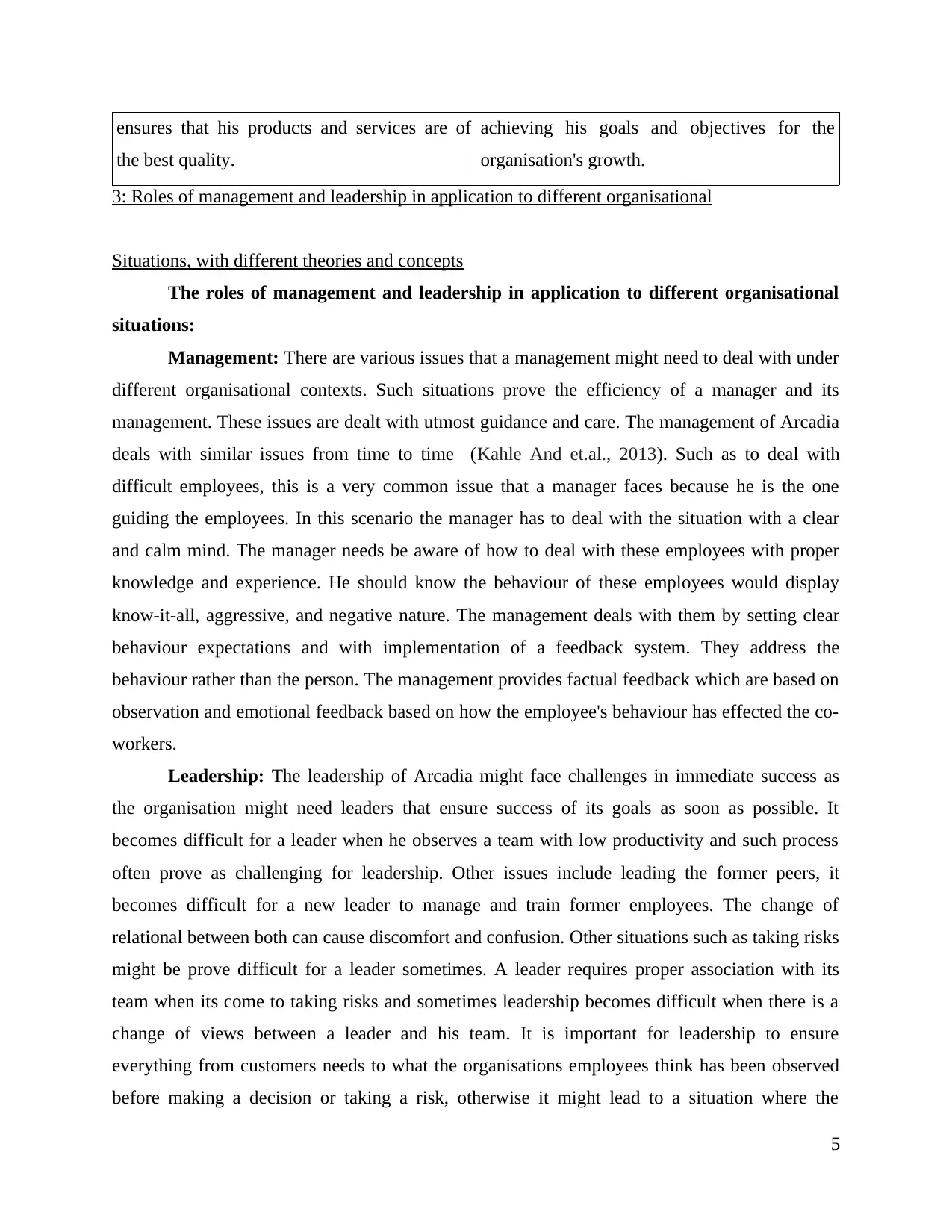
ensures that his products and services are of
the best quality.
achieving his goals and objectives for the
organisation's growth.
3: Roles of management and leadership in application to different organisational
Situations, with different theories and concepts
The roles of management and leadership in application to different organisational
situations:
Management: There are various issues that a management might need to deal with under
different organisational contexts. Such situations prove the efficiency of a manager and its
management. These issues are dealt with utmost guidance and care. The management of Arcadia
deals with similar issues from time to time (Kahle And et.al., 2013). Such as to deal with
difficult employees, this is a very common issue that a manager faces because he is the one
guiding the employees. In this scenario the manager has to deal with the situation with a clear
and calm mind. The manager needs be aware of how to deal with these employees with proper
knowledge and experience. He should know the behaviour of these employees would display
know-it-all, aggressive, and negative nature. The management deals with them by setting clear
behaviour expectations and with implementation of a feedback system. They address the
behaviour rather than the person. The management provides factual feedback which are based on
observation and emotional feedback based on how the employee's behaviour has effected the co-
workers.
Leadership: The leadership of Arcadia might face challenges in immediate success as
the organisation might need leaders that ensure success of its goals as soon as possible. It
becomes difficult for a leader when he observes a team with low productivity and such process
often prove as challenging for leadership. Other issues include leading the former peers, it
becomes difficult for a new leader to manage and train former employees. The change of
relational between both can cause discomfort and confusion. Other situations such as taking risks
might be prove difficult for a leader sometimes. A leader requires proper association with its
team when its come to taking risks and sometimes leadership becomes difficult when there is a
change of views between a leader and his team. It is important for leadership to ensure
everything from customers needs to what the organisations employees think has been observed
before making a decision or taking a risk, otherwise it might lead to a situation where the
5
the best quality.
achieving his goals and objectives for the
organisation's growth.
3: Roles of management and leadership in application to different organisational
Situations, with different theories and concepts
The roles of management and leadership in application to different organisational
situations:
Management: There are various issues that a management might need to deal with under
different organisational contexts. Such situations prove the efficiency of a manager and its
management. These issues are dealt with utmost guidance and care. The management of Arcadia
deals with similar issues from time to time (Kahle And et.al., 2013). Such as to deal with
difficult employees, this is a very common issue that a manager faces because he is the one
guiding the employees. In this scenario the manager has to deal with the situation with a clear
and calm mind. The manager needs be aware of how to deal with these employees with proper
knowledge and experience. He should know the behaviour of these employees would display
know-it-all, aggressive, and negative nature. The management deals with them by setting clear
behaviour expectations and with implementation of a feedback system. They address the
behaviour rather than the person. The management provides factual feedback which are based on
observation and emotional feedback based on how the employee's behaviour has effected the co-
workers.
Leadership: The leadership of Arcadia might face challenges in immediate success as
the organisation might need leaders that ensure success of its goals as soon as possible. It
becomes difficult for a leader when he observes a team with low productivity and such process
often prove as challenging for leadership. Other issues include leading the former peers, it
becomes difficult for a new leader to manage and train former employees. The change of
relational between both can cause discomfort and confusion. Other situations such as taking risks
might be prove difficult for a leader sometimes. A leader requires proper association with its
team when its come to taking risks and sometimes leadership becomes difficult when there is a
change of views between a leader and his team. It is important for leadership to ensure
everything from customers needs to what the organisations employees think has been observed
before making a decision or taking a risk, otherwise it might lead to a situation where the
5
Paraphrase This Document
Need a fresh take? Get an instant paraphrase of this document with our AI Paraphraser
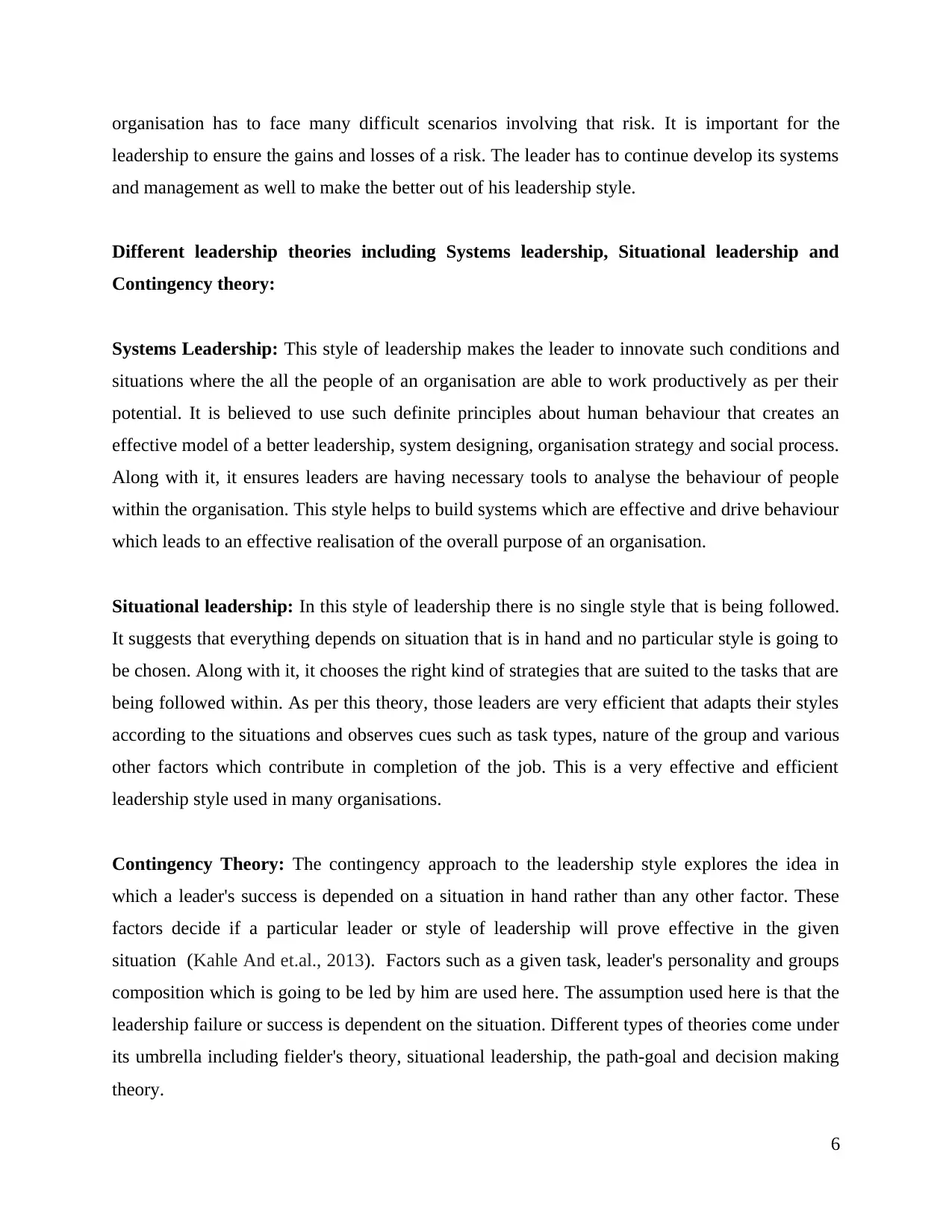
organisation has to face many difficult scenarios involving that risk. It is important for the
leadership to ensure the gains and losses of a risk. The leader has to continue develop its systems
and management as well to make the better out of his leadership style.
Different leadership theories including Systems leadership, Situational leadership and
Contingency theory:
Systems Leadership: This style of leadership makes the leader to innovate such conditions and
situations where the all the people of an organisation are able to work productively as per their
potential. It is believed to use such definite principles about human behaviour that creates an
effective model of a better leadership, system designing, organisation strategy and social process.
Along with it, it ensures leaders are having necessary tools to analyse the behaviour of people
within the organisation. This style helps to build systems which are effective and drive behaviour
which leads to an effective realisation of the overall purpose of an organisation.
Situational leadership: In this style of leadership there is no single style that is being followed.
It suggests that everything depends on situation that is in hand and no particular style is going to
be chosen. Along with it, it chooses the right kind of strategies that are suited to the tasks that are
being followed within. As per this theory, those leaders are very efficient that adapts their styles
according to the situations and observes cues such as task types, nature of the group and various
other factors which contribute in completion of the job. This is a very effective and efficient
leadership style used in many organisations.
Contingency Theory: The contingency approach to the leadership style explores the idea in
which a leader's success is depended on a situation in hand rather than any other factor. These
factors decide if a particular leader or style of leadership will prove effective in the given
situation (Kahle And et.al., 2013). Factors such as a given task, leader's personality and groups
composition which is going to be led by him are used here. The assumption used here is that the
leadership failure or success is dependent on the situation. Different types of theories come under
its umbrella including fielder's theory, situational leadership, the path-goal and decision making
theory.
6
leadership to ensure the gains and losses of a risk. The leader has to continue develop its systems
and management as well to make the better out of his leadership style.
Different leadership theories including Systems leadership, Situational leadership and
Contingency theory:
Systems Leadership: This style of leadership makes the leader to innovate such conditions and
situations where the all the people of an organisation are able to work productively as per their
potential. It is believed to use such definite principles about human behaviour that creates an
effective model of a better leadership, system designing, organisation strategy and social process.
Along with it, it ensures leaders are having necessary tools to analyse the behaviour of people
within the organisation. This style helps to build systems which are effective and drive behaviour
which leads to an effective realisation of the overall purpose of an organisation.
Situational leadership: In this style of leadership there is no single style that is being followed.
It suggests that everything depends on situation that is in hand and no particular style is going to
be chosen. Along with it, it chooses the right kind of strategies that are suited to the tasks that are
being followed within. As per this theory, those leaders are very efficient that adapts their styles
according to the situations and observes cues such as task types, nature of the group and various
other factors which contribute in completion of the job. This is a very effective and efficient
leadership style used in many organisations.
Contingency Theory: The contingency approach to the leadership style explores the idea in
which a leader's success is depended on a situation in hand rather than any other factor. These
factors decide if a particular leader or style of leadership will prove effective in the given
situation (Kahle And et.al., 2013). Factors such as a given task, leader's personality and groups
composition which is going to be led by him are used here. The assumption used here is that the
leadership failure or success is dependent on the situation. Different types of theories come under
its umbrella including fielder's theory, situational leadership, the path-goal and decision making
theory.
6
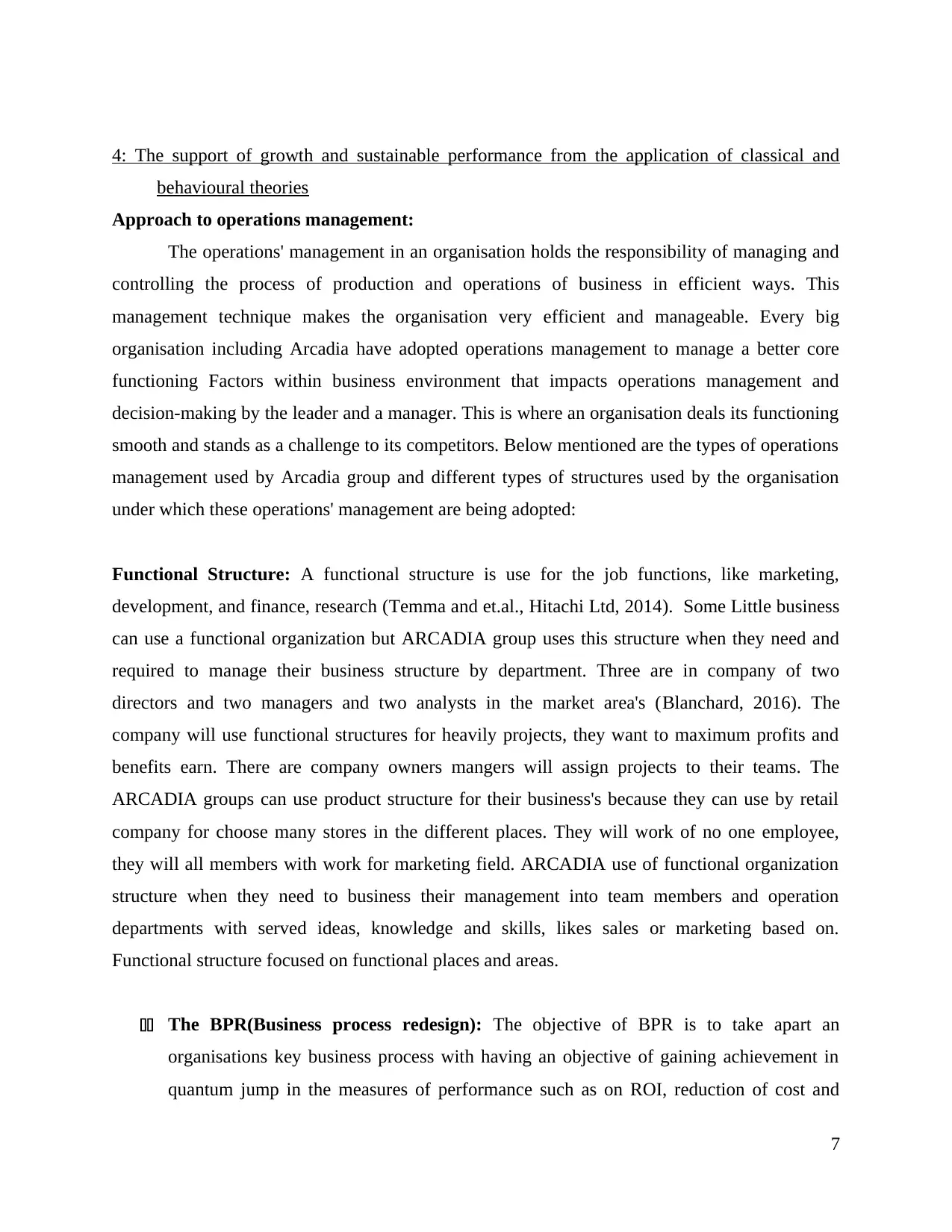
4: The support of growth and sustainable performance from the application of classical and
behavioural theories
Approach to operations management:
The operations' management in an organisation holds the responsibility of managing and
controlling the process of production and operations of business in efficient ways. This
management technique makes the organisation very efficient and manageable. Every big
organisation including Arcadia have adopted operations management to manage a better core
functioning Factors within business environment that impacts operations management and
decision-making by the leader and a manager. This is where an organisation deals its functioning
smooth and stands as a challenge to its competitors. Below mentioned are the types of operations
management used by Arcadia group and different types of structures used by the organisation
under which these operations' management are being adopted:
Functional Structure: A functional structure is use for the job functions, like marketing,
development, and finance, research (Temma and et.al., Hitachi Ltd, 2014). Some Little business
can use a functional organization but ARCADIA group uses this structure when they need and
required to manage their business structure by department. Three are in company of two
directors and two managers and two analysts in the market area's (Blanchard, 2016). The
company will use functional structures for heavily projects, they want to maximum profits and
benefits earn. There are company owners mangers will assign projects to their teams. The
ARCADIA groups can use product structure for their business's because they can use by retail
company for choose many stores in the different places. They will work of no one employee,
they will all members with work for marketing field. ARCADIA use of functional organization
structure when they need to business their management into team members and operation
departments with served ideas, knowledge and skills, likes sales or marketing based on.
Functional structure focused on functional places and areas.
11 The BPR(Business process redesign): The objective of BPR is to take apart an
organisations key business process with having an objective of gaining achievement in
quantum jump in the measures of performance such as on ROI, reduction of cost and
7
behavioural theories
Approach to operations management:
The operations' management in an organisation holds the responsibility of managing and
controlling the process of production and operations of business in efficient ways. This
management technique makes the organisation very efficient and manageable. Every big
organisation including Arcadia have adopted operations management to manage a better core
functioning Factors within business environment that impacts operations management and
decision-making by the leader and a manager. This is where an organisation deals its functioning
smooth and stands as a challenge to its competitors. Below mentioned are the types of operations
management used by Arcadia group and different types of structures used by the organisation
under which these operations' management are being adopted:
Functional Structure: A functional structure is use for the job functions, like marketing,
development, and finance, research (Temma and et.al., Hitachi Ltd, 2014). Some Little business
can use a functional organization but ARCADIA group uses this structure when they need and
required to manage their business structure by department. Three are in company of two
directors and two managers and two analysts in the market area's (Blanchard, 2016). The
company will use functional structures for heavily projects, they want to maximum profits and
benefits earn. There are company owners mangers will assign projects to their teams. The
ARCADIA groups can use product structure for their business's because they can use by retail
company for choose many stores in the different places. They will work of no one employee,
they will all members with work for marketing field. ARCADIA use of functional organization
structure when they need to business their management into team members and operation
departments with served ideas, knowledge and skills, likes sales or marketing based on.
Functional structure focused on functional places and areas.
11 The BPR(Business process redesign): The objective of BPR is to take apart an
organisations key business process with having an objective of gaining achievement in
quantum jump in the measures of performance such as on ROI, reduction of cost and
7
⊘ This is a preview!⊘
Do you want full access?
Subscribe today to unlock all pages.

Trusted by 1+ million students worldwide
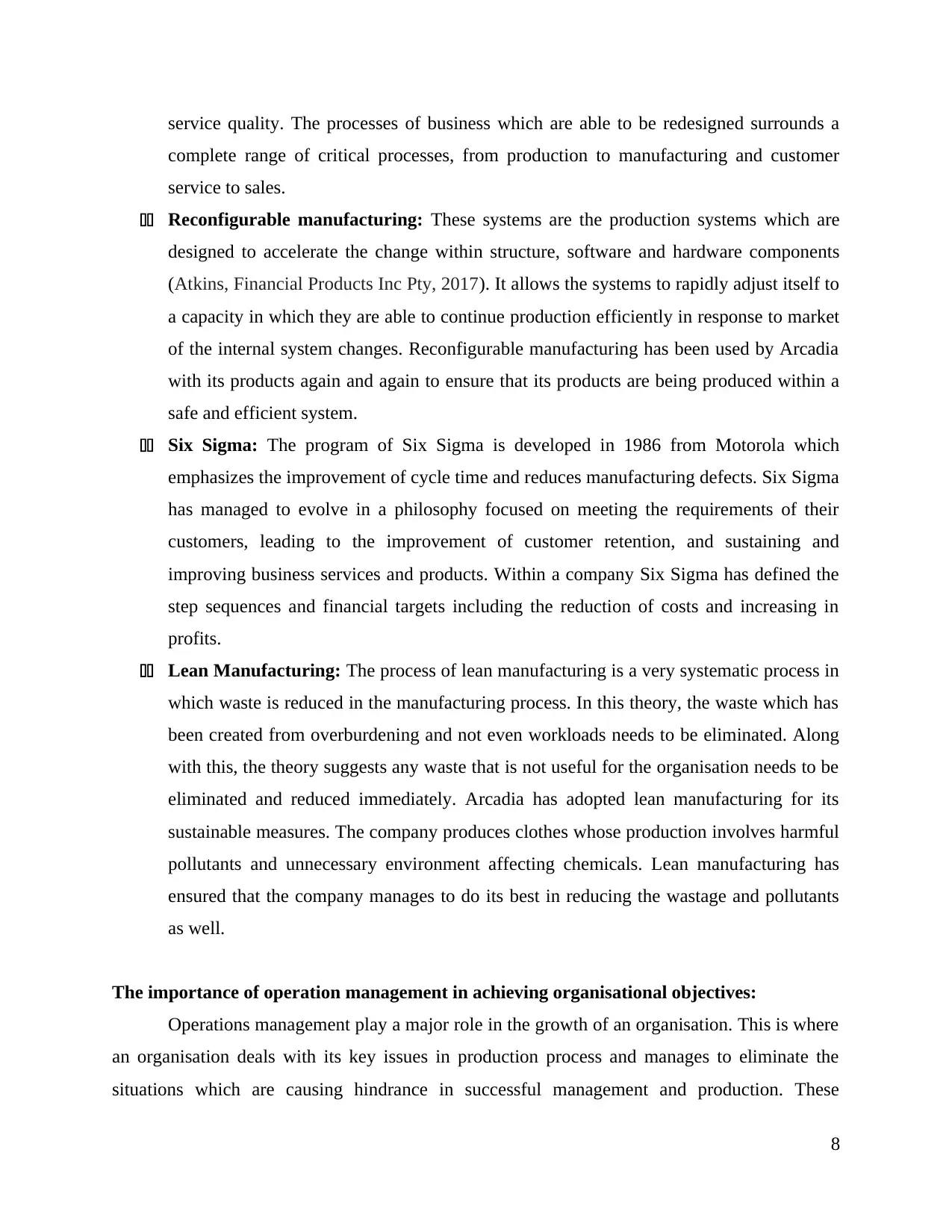
service quality. The processes of business which are able to be redesigned surrounds a
complete range of critical processes, from production to manufacturing and customer
service to sales.
11 Reconfigurable manufacturing: These systems are the production systems which are
designed to accelerate the change within structure, software and hardware components
(Atkins, Financial Products Inc Pty, 2017). It allows the systems to rapidly adjust itself to
a capacity in which they are able to continue production efficiently in response to market
of the internal system changes. Reconfigurable manufacturing has been used by Arcadia
with its products again and again to ensure that its products are being produced within a
safe and efficient system.
11 Six Sigma: The program of Six Sigma is developed in 1986 from Motorola which
emphasizes the improvement of cycle time and reduces manufacturing defects. Six Sigma
has managed to evolve in a philosophy focused on meeting the requirements of their
customers, leading to the improvement of customer retention, and sustaining and
improving business services and products. Within a company Six Sigma has defined the
step sequences and financial targets including the reduction of costs and increasing in
profits.
11 Lean Manufacturing: The process of lean manufacturing is a very systematic process in
which waste is reduced in the manufacturing process. In this theory, the waste which has
been created from overburdening and not even workloads needs to be eliminated. Along
with this, the theory suggests any waste that is not useful for the organisation needs to be
eliminated and reduced immediately. Arcadia has adopted lean manufacturing for its
sustainable measures. The company produces clothes whose production involves harmful
pollutants and unnecessary environment affecting chemicals. Lean manufacturing has
ensured that the company manages to do its best in reducing the wastage and pollutants
as well.
The importance of operation management in achieving organisational objectives:
Operations management play a major role in the growth of an organisation. This is where
an organisation deals with its key issues in production process and manages to eliminate the
situations which are causing hindrance in successful management and production. These
8
complete range of critical processes, from production to manufacturing and customer
service to sales.
11 Reconfigurable manufacturing: These systems are the production systems which are
designed to accelerate the change within structure, software and hardware components
(Atkins, Financial Products Inc Pty, 2017). It allows the systems to rapidly adjust itself to
a capacity in which they are able to continue production efficiently in response to market
of the internal system changes. Reconfigurable manufacturing has been used by Arcadia
with its products again and again to ensure that its products are being produced within a
safe and efficient system.
11 Six Sigma: The program of Six Sigma is developed in 1986 from Motorola which
emphasizes the improvement of cycle time and reduces manufacturing defects. Six Sigma
has managed to evolve in a philosophy focused on meeting the requirements of their
customers, leading to the improvement of customer retention, and sustaining and
improving business services and products. Within a company Six Sigma has defined the
step sequences and financial targets including the reduction of costs and increasing in
profits.
11 Lean Manufacturing: The process of lean manufacturing is a very systematic process in
which waste is reduced in the manufacturing process. In this theory, the waste which has
been created from overburdening and not even workloads needs to be eliminated. Along
with this, the theory suggests any waste that is not useful for the organisation needs to be
eliminated and reduced immediately. Arcadia has adopted lean manufacturing for its
sustainable measures. The company produces clothes whose production involves harmful
pollutants and unnecessary environment affecting chemicals. Lean manufacturing has
ensured that the company manages to do its best in reducing the wastage and pollutants
as well.
The importance of operation management in achieving organisational objectives:
Operations management play a major role in the growth of an organisation. This is where
an organisation deals with its key issues in production process and manages to eliminate the
situations which are causing hindrance in successful management and production. These
8
Paraphrase This Document
Need a fresh take? Get an instant paraphrase of this document with our AI Paraphraser
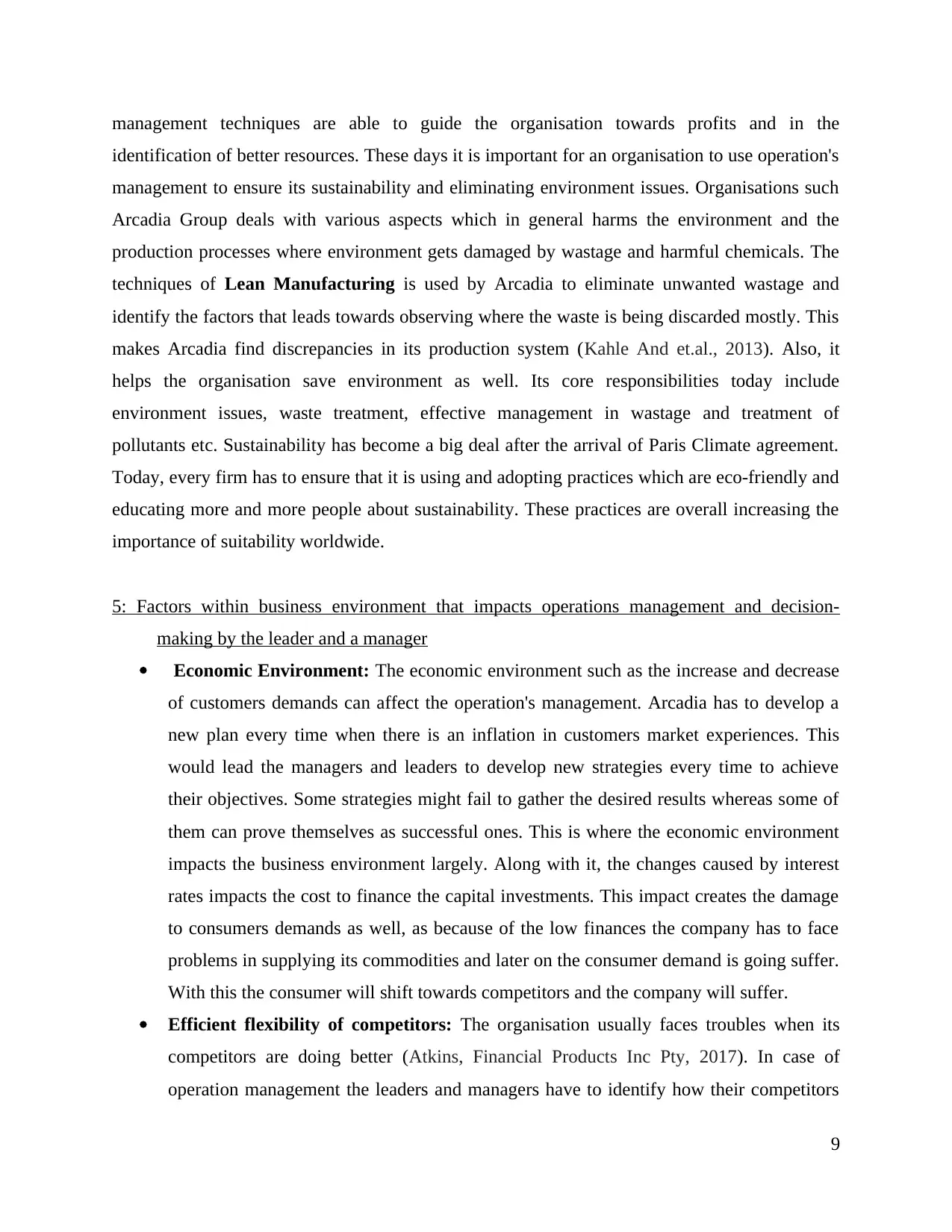
management techniques are able to guide the organisation towards profits and in the
identification of better resources. These days it is important for an organisation to use operation's
management to ensure its sustainability and eliminating environment issues. Organisations such
Arcadia Group deals with various aspects which in general harms the environment and the
production processes where environment gets damaged by wastage and harmful chemicals. The
techniques of Lean Manufacturing is used by Arcadia to eliminate unwanted wastage and
identify the factors that leads towards observing where the waste is being discarded mostly. This
makes Arcadia find discrepancies in its production system (Kahle And et.al., 2013). Also, it
helps the organisation save environment as well. Its core responsibilities today include
environment issues, waste treatment, effective management in wastage and treatment of
pollutants etc. Sustainability has become a big deal after the arrival of Paris Climate agreement.
Today, every firm has to ensure that it is using and adopting practices which are eco-friendly and
educating more and more people about sustainability. These practices are overall increasing the
importance of suitability worldwide.
5: Factors within business environment that impacts operations management and decision-
making by the leader and a manager
Economic Environment: The economic environment such as the increase and decrease
of customers demands can affect the operation's management. Arcadia has to develop a
new plan every time when there is an inflation in customers market experiences. This
would lead the managers and leaders to develop new strategies every time to achieve
their objectives. Some strategies might fail to gather the desired results whereas some of
them can prove themselves as successful ones. This is where the economic environment
impacts the business environment largely. Along with it, the changes caused by interest
rates impacts the cost to finance the capital investments. This impact creates the damage
to consumers demands as well, as because of the low finances the company has to face
problems in supplying its commodities and later on the consumer demand is going suffer.
With this the consumer will shift towards competitors and the company will suffer.
Efficient flexibility of competitors: The organisation usually faces troubles when its
competitors are doing better (Atkins, Financial Products Inc Pty, 2017). In case of
operation management the leaders and managers have to identify how their competitors
9
identification of better resources. These days it is important for an organisation to use operation's
management to ensure its sustainability and eliminating environment issues. Organisations such
Arcadia Group deals with various aspects which in general harms the environment and the
production processes where environment gets damaged by wastage and harmful chemicals. The
techniques of Lean Manufacturing is used by Arcadia to eliminate unwanted wastage and
identify the factors that leads towards observing where the waste is being discarded mostly. This
makes Arcadia find discrepancies in its production system (Kahle And et.al., 2013). Also, it
helps the organisation save environment as well. Its core responsibilities today include
environment issues, waste treatment, effective management in wastage and treatment of
pollutants etc. Sustainability has become a big deal after the arrival of Paris Climate agreement.
Today, every firm has to ensure that it is using and adopting practices which are eco-friendly and
educating more and more people about sustainability. These practices are overall increasing the
importance of suitability worldwide.
5: Factors within business environment that impacts operations management and decision-
making by the leader and a manager
Economic Environment: The economic environment such as the increase and decrease
of customers demands can affect the operation's management. Arcadia has to develop a
new plan every time when there is an inflation in customers market experiences. This
would lead the managers and leaders to develop new strategies every time to achieve
their objectives. Some strategies might fail to gather the desired results whereas some of
them can prove themselves as successful ones. This is where the economic environment
impacts the business environment largely. Along with it, the changes caused by interest
rates impacts the cost to finance the capital investments. This impact creates the damage
to consumers demands as well, as because of the low finances the company has to face
problems in supplying its commodities and later on the consumer demand is going suffer.
With this the consumer will shift towards competitors and the company will suffer.
Efficient flexibility of competitors: The organisation usually faces troubles when its
competitors are doing better (Atkins, Financial Products Inc Pty, 2017). In case of
operation management the leaders and managers have to identify how their competitors
9
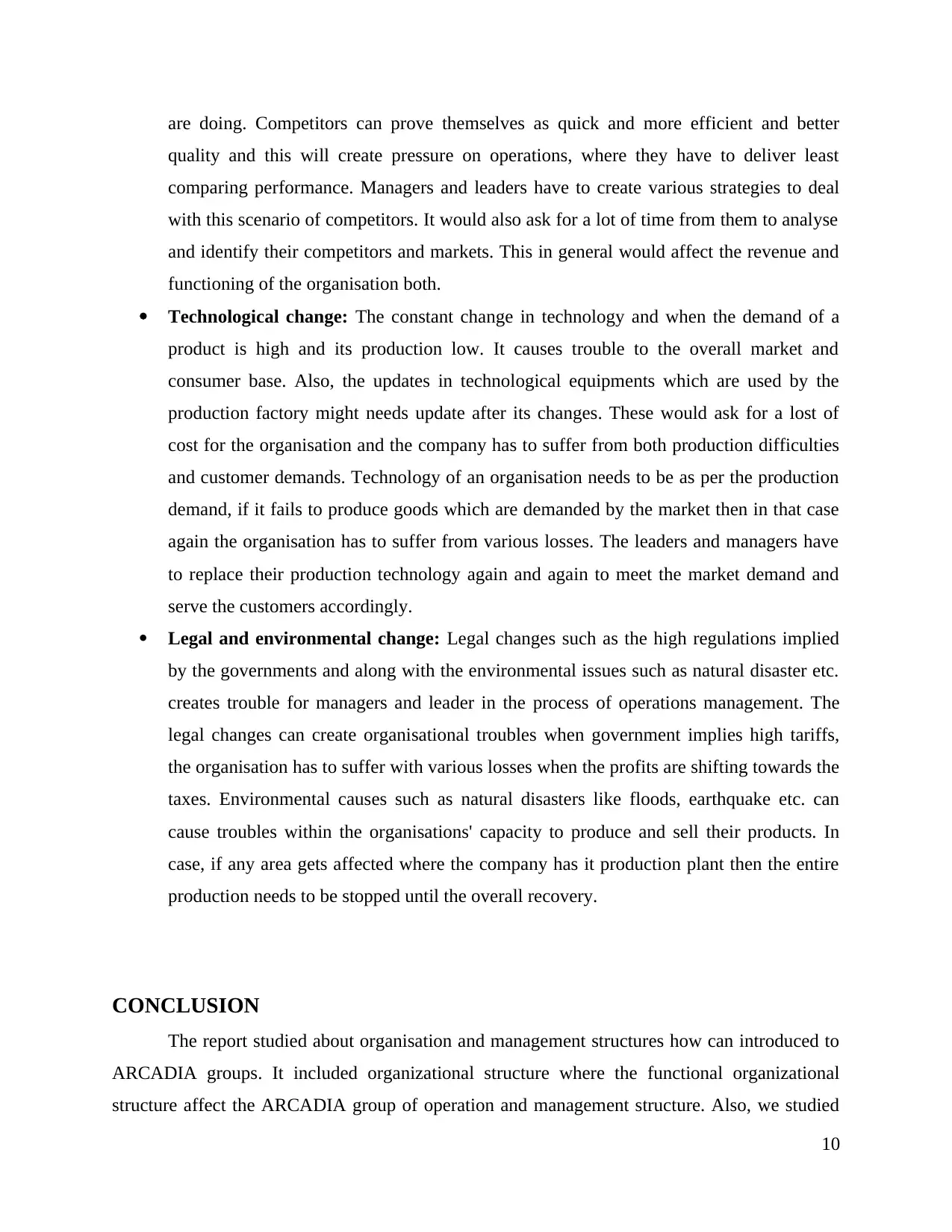
are doing. Competitors can prove themselves as quick and more efficient and better
quality and this will create pressure on operations, where they have to deliver least
comparing performance. Managers and leaders have to create various strategies to deal
with this scenario of competitors. It would also ask for a lot of time from them to analyse
and identify their competitors and markets. This in general would affect the revenue and
functioning of the organisation both.
Technological change: The constant change in technology and when the demand of a
product is high and its production low. It causes trouble to the overall market and
consumer base. Also, the updates in technological equipments which are used by the
production factory might needs update after its changes. These would ask for a lost of
cost for the organisation and the company has to suffer from both production difficulties
and customer demands. Technology of an organisation needs to be as per the production
demand, if it fails to produce goods which are demanded by the market then in that case
again the organisation has to suffer from various losses. The leaders and managers have
to replace their production technology again and again to meet the market demand and
serve the customers accordingly.
Legal and environmental change: Legal changes such as the high regulations implied
by the governments and along with the environmental issues such as natural disaster etc.
creates trouble for managers and leader in the process of operations management. The
legal changes can create organisational troubles when government implies high tariffs,
the organisation has to suffer with various losses when the profits are shifting towards the
taxes. Environmental causes such as natural disasters like floods, earthquake etc. can
cause troubles within the organisations' capacity to produce and sell their products. In
case, if any area gets affected where the company has it production plant then the entire
production needs to be stopped until the overall recovery.
CONCLUSION
The report studied about organisation and management structures how can introduced to
ARCADIA groups. It included organizational structure where the functional organizational
structure affect the ARCADIA group of operation and management structure. Also, we studied
10
quality and this will create pressure on operations, where they have to deliver least
comparing performance. Managers and leaders have to create various strategies to deal
with this scenario of competitors. It would also ask for a lot of time from them to analyse
and identify their competitors and markets. This in general would affect the revenue and
functioning of the organisation both.
Technological change: The constant change in technology and when the demand of a
product is high and its production low. It causes trouble to the overall market and
consumer base. Also, the updates in technological equipments which are used by the
production factory might needs update after its changes. These would ask for a lost of
cost for the organisation and the company has to suffer from both production difficulties
and customer demands. Technology of an organisation needs to be as per the production
demand, if it fails to produce goods which are demanded by the market then in that case
again the organisation has to suffer from various losses. The leaders and managers have
to replace their production technology again and again to meet the market demand and
serve the customers accordingly.
Legal and environmental change: Legal changes such as the high regulations implied
by the governments and along with the environmental issues such as natural disaster etc.
creates trouble for managers and leader in the process of operations management. The
legal changes can create organisational troubles when government implies high tariffs,
the organisation has to suffer with various losses when the profits are shifting towards the
taxes. Environmental causes such as natural disasters like floods, earthquake etc. can
cause troubles within the organisations' capacity to produce and sell their products. In
case, if any area gets affected where the company has it production plant then the entire
production needs to be stopped until the overall recovery.
CONCLUSION
The report studied about organisation and management structures how can introduced to
ARCADIA groups. It included organizational structure where the functional organizational
structure affect the ARCADIA group of operation and management structure. Also, we studied
10
⊘ This is a preview!⊘
Do you want full access?
Subscribe today to unlock all pages.

Trusted by 1+ million students worldwide
1 out of 14
Related Documents
Your All-in-One AI-Powered Toolkit for Academic Success.
+13062052269
info@desklib.com
Available 24*7 on WhatsApp / Email
![[object Object]](/_next/static/media/star-bottom.7253800d.svg)
Unlock your academic potential
Copyright © 2020–2025 A2Z Services. All Rights Reserved. Developed and managed by ZUCOL.




